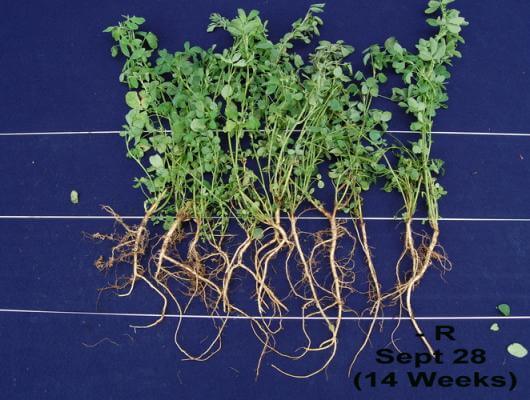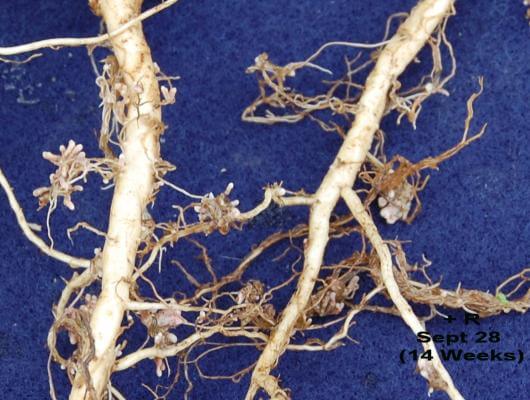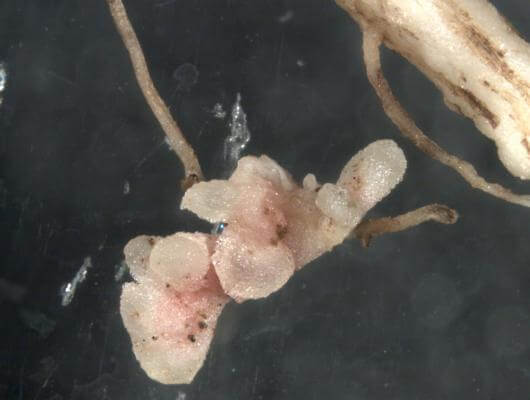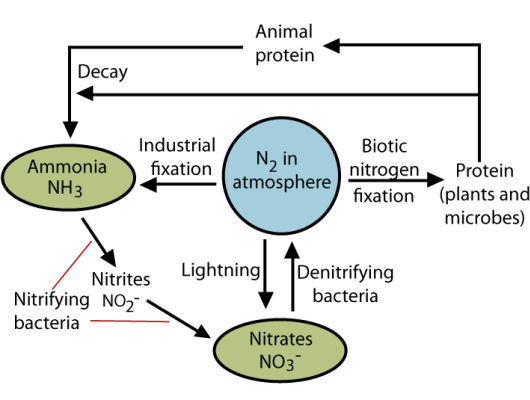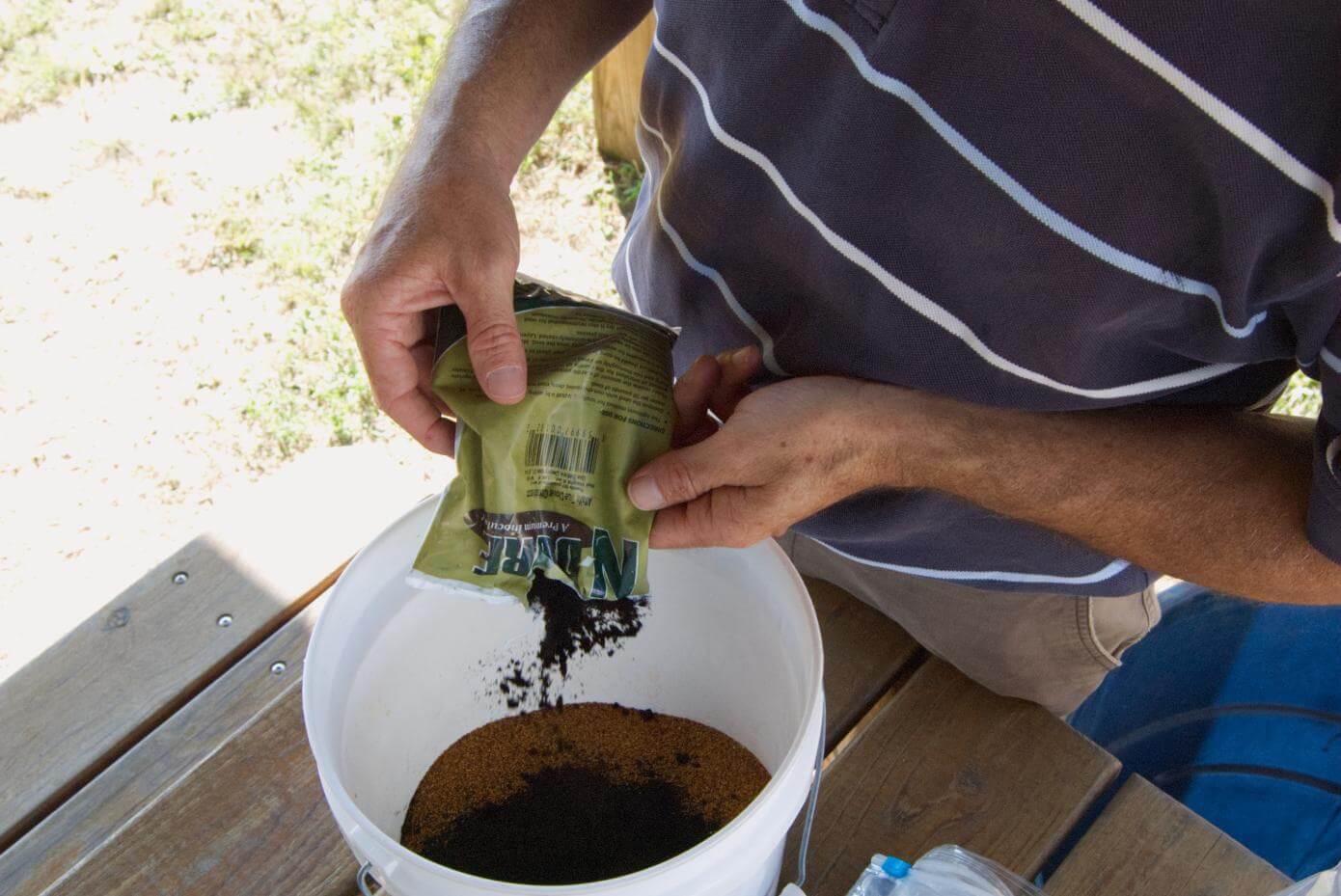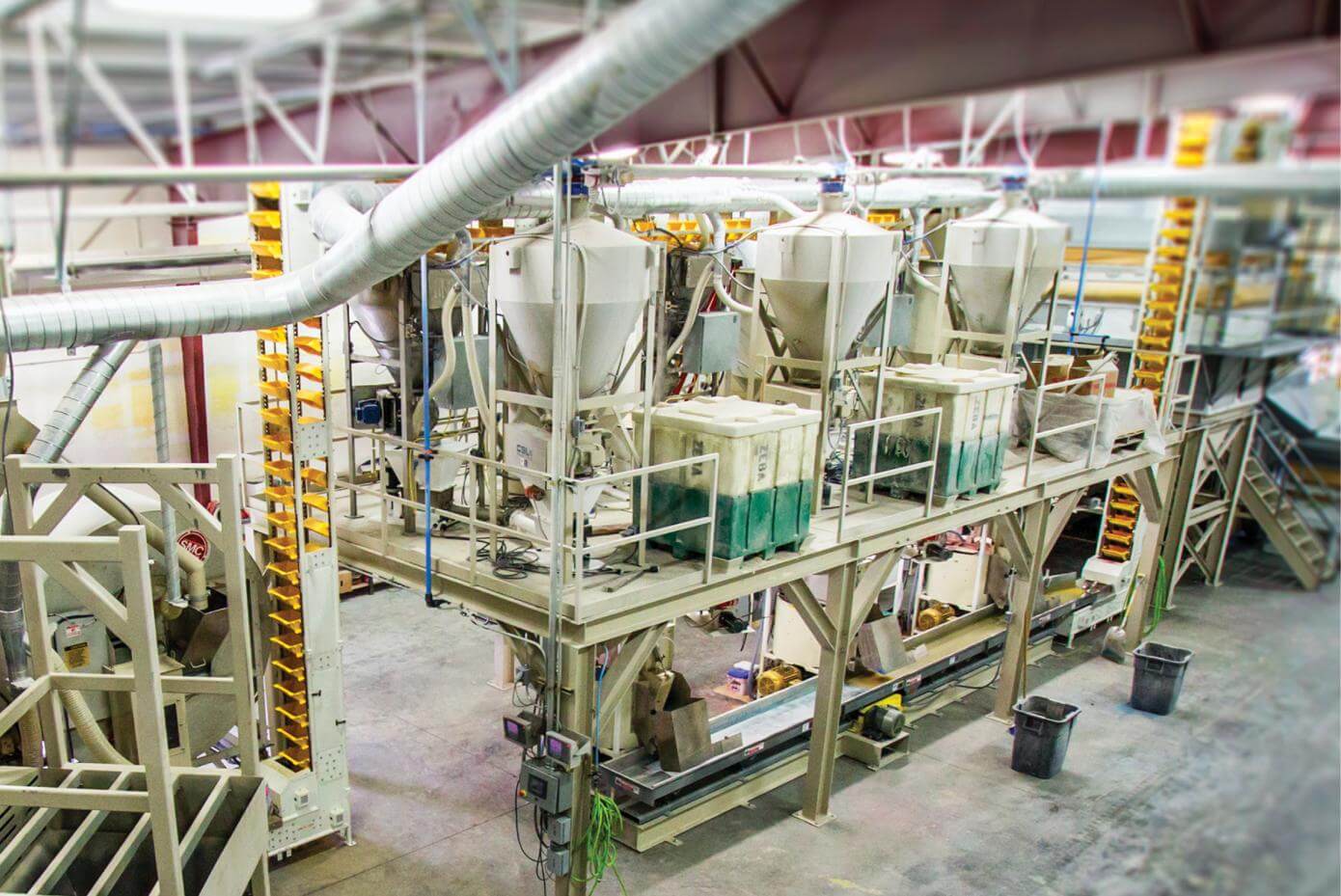Seed Coating
What are Rhizobium bacteria?
Rhizobia are free-living soil bacteria that form a specific and agriculturally important relationship called “nitrogen fixation” when they infect the roots of legume crop species to form nodules. This relationship is defined as a “symbiosis” because it is mutually beneficial to both the Rhizobium and the host legume plant. In this symbiosis, the plant receives reduced nitrogen for its growth through nitrogen fixation, while Rhizobia are provided energy-containing carbohydrates and nutrients from the plant. The symbiosis only takes place when there is a match between a specific species of both the Rhizobia and the legume crop. Therefore, alfalfa is infected only by Rhizobium meliloti, clovers by Rhizobium trifolii, beans and peas by Rhizobium leguminosaeum, etc. Certain chemical signals from the right legume roots must be recognized by the specific Rhizobium species for the infection, nodulation, and nitrogen fixation processes to be successful. The Nitro-Coat® process ensures that Rhizobium of the correctly matched species is applied directly to the coated seed.
What are the Rhizobial Infection, Nodulation, and Nitrogen Fixation Processes?
When the correct Rhizobium species reads the chemical signals from the specific legume roots, they congregate at those roots at the root hairs (Step 1). Infection begins when the root hair “curls” around the Rhizobia and encloses them (Step 2). An “infection thread” then forms (Steps 3 and 4). The infection thread is simply a folding-in of the root hair membrane so that it encloses the replicating Rhizobia while they grow into the root until they reach the root cortical cell layer. The thread branches out into the cortical cell layer (Step 5) and the cortical cells begin to multiply due to the infection (Step 6) forming the young nodule (Step 7). The Rhizobia multiplies further in these nodule cells and then enlarges to become bacteroids, or the form that is capable of fixing nitrogen (Step 8). Nitrogenase, the actual nitrogen-fixing enzyme, is synthesized inside the mature nodule and bacteroids (Step 8). However, nitrogenase is deactivated by oxygen, so another critical compound produced is leghemoglobin which is responsible for capturing oxygen and moving it away from the nitrogenase enzyme. Therefore, when the mature nodule and bacteroids are functioning properly, nitrogen gas seeps into the nodule and is reduced chemically into ammonia which is in turn converted to amino acids that are transported throughout the legume plant for its metabolism and growth as protein. The Nitro-Coat® process places the proper Rhizobium next to the seed so that infection begins as soon as the root hairs emerge.
Do all legumes need Rhizobium?
Like other crops, non-nodulated legumes can grow very well using soil nitrogen supplied as commercial fertilizer. However, doing so removes the important natural process of biological nitrogen fixation from the nitrogen cycle of any agricultural production system. This is because the manufacture of commercial nitrogen is expensive; especially in terms of energy use and final cost to the farmer. Achieving high levels of nitrogen for incorporation into the soil (a practice called “green manuring”) or high protein levels in the harvested product, all freely obtained with Rhizobium inoculation and infection is simply better and more cost-effective for any farmer. The Nitro-Coat® process equips legumes to freely collect nitrogen and incorporate these into the nitrogen cycle, allowing reduced usage of costly commercial fertilizer.
Do improved varieties still need good Rhizobium?
Most improved legume varieties are bred for superior performance for all important traits including an ability to serve as the best host for Rhizobium. Nitro-Coat®, by delivering high numbers of effective Rhizobium strains and other additives, simply facilitates and maximizes the inherent infection, nodulation, and nitrogen fixation potential of any improved variety. One would therefore need to ask themselves the practical question: Why would I pay proprietary prices for raw seed of an improved variety and then take the risk of inoculating the seed myself which may result in poor Rhizobium infection? Otherwise, one might as well buy and take that same risk with cheap commodity seed. The Nitro-Coat® process maximizes a variety's performance capability.
How did the Rhizobium-legume crop symbioses assume its current important role in world agriculture?
The value of legumes for human food production, as directly consumed (beans, peas, etc.) or indirectly as livestock fodder (alfalfa, clovers, etc.), has been known for a very long time even back to the days of the Roman Empire. Fixing nitrogen directly and freely from the air only added to its agricultural importance. It was not until the late 1800s that a German scientist, H. Hellriegel, reported that peas could only be productively grown when nodules formed on their roots. In quick succession, a Dutch scientist, M.W. Beijerinck, isolated the main causal organism from the nodule that was later called Rhizobium. Once Rhizobium could be isolated and identified the next logical step was for microbiologists to learn to grow the Rhizobia in quantity and for agriculturalists to find out the best way to supply them to the roots of legume plants in a process called “inoculation”. The Nitro-Coat® process is based on the fundamental value of inoculating seed with the correct strain of Rhizobium.
What is Rhizobium inoculation and how is it practiced?
Early inoculation practices included spreading soil from land where the crop had previously grown. Over time, seed inoculation became more science-based and exact. Close seed placement of live, effective strains grown and packaged as sterile, peat-based media and applied to the seed with a “sticker”, or directly into the planter box, became the main inoculation practice (Figure 4). This was usually done by the farmer at the time of planting. The more advanced technique, which is the common practice today, applies inoculant on the seed with a protective coating. The Nitro-Coat® process uses state-of-the-art technology and fundamental science to ensure a high number of live Rhizobium are delivered to each seed.
Why do we inoculate?
Although many extension publications are freely available that outline in a stepwise fashion how to inoculate legume seed, there were many stand failures in the past due to such things as farmers using the wrong Rhizobium (example: soybean type for alfalfa) or skipping one of the important steps (for example: not using an adhesive to get good seed contact). Many farmers also simply did not inoculate because they forgot why they needed to inoculate in the first place – it’s to deliver effective Rhizobium to the germinating seed! The movement in the modern seed industry toward pre-inoculated, coated seed was therefore inevitable due to these on-farm failures. It simply delivered the best stand possible. The Nitro-Coat® process delivers the right Rhizobium to each and every seed.
Why use coated seed? Isn't it better to inoculate the legume crop myself?
Historically, when inoculation is done by farmers at the time of planting, poor results are all too common. Sometimes, this is due to using the wrong inoculant (for example, using soybean Rhizobia for alfalfa). Also, poor handling and storage of an inoculant can lead to Rhizobia desiccation and death even before it is applied. Nitro-Coated® seed leads to more consistent inoculation results and is the most ideal way to obtain successful legume stands. In addition to supplying the best strains of the right Rhizobium species, coating helps with seed flow through the planter. Further benefits include supplying lime and fungicides at the germinating root zone to provide for a better “micro-environment” for the young seedling roots. The Nitro-Coat® process is more consistent than inoculating at the time of seeding, provides better seed flow, and enhances the seed’s micro-environment for greater seedling survivability.
Why is it important to have high numbers of Rhizobium for each seed? Isn't one enough?
Inoculation is fundamentally a numbers game and one Rhizobium per seed is definitely too low of a number! The environment in the germinating root zone, especially at the root hairs, has many problems. It is a microscopic war zone, with many “enemies” that can get in the way of correct Rhizobium properly infecting plants. First, there are other Rhizobium residing in the soil. These compete to attach to the host plant. Second, other parasites (other microbes or fauna) prey on good Rhizobium inoculum. Third, a poor soil environment, low fertility or caustic pH or salts (very acidic or alkaline soils) will reduce Rhizobium population. High numbers of effective Rhizobium encased in a very good coating are needed in order to mitigate these problems. The Nitro-Coat® process is designed specifically to do just that. From the inception of its design to the execution of every coated pound of seed, the Nitro-Coat® process aims to provide the highest possible numbers of live Rhizobium to each seed at the time of planting.
What makes the Nitro-Coat® process superior to other ways of applying inoculant?
There are two ways to inoculate seed. The first is conducted on-site just prior to planting. It is inefficient, messy, and has a high risk of failure. Experience shows this method to have limited success. The second method is pre-inoculation of the seed during seed packaging. This method has the potential to be much more successful than the on-site method and that is why the practice is now more common than on-site inoculating.
What sets Nitro-Coat® apart from other pre-inoculation operations is a unique process that focuses on two key components, maximizing live Rhizobium and coating durability. From the very inception and development of the Nitro-Coat® facility and process, these two essential components of success direct the process and the product. Our on-site lab, quality control process, experienced technicians, and state-of-the-art equipment, provide consistent high, live Rhizobium encased in a durable coating package. The end result is high-performing legumes that are easily sown and establish strong with high nodulation rates. The Nitro-Coat® process is uniquely designed, equipped, and operated to ensure a consistent, high level of live Rhizobium and seed durability.
Do I need to increase my seeding rate when using Nitro-Coated® seed?
Seed coating adds weight to legume seed; sometimes increasing it by one-third. When calibrating and planting by seed weight, one may need to take that fact into account. However, research studies have found that pre-inoculated, coated seed provides final seedling stands that are equal to, or in many cases, better than that of un-coated seed when planted at the same seeding rate. Therefore, one can normally plant coated seed at the same rate in terms of pounds per acre as they do uncoated seed. The Nitro-Coat® process is cost-effective and easy to use.
Are there any potential problems with using Nitro-Coated® seed?
Important pre-inoculation and coating criteria to insure inoculation success are 1) maximizing high numbers of the best Rhizobium strains in the initially coated seed, yet 2) eliminating coating break-down in the bag during handling and shipment. Australian researchers had reported that Rhizobium survival on pre-inoculated seed is highly variable by company and can be very poor after pre-inoculation due to several factors. Two very important factors in their findings were the Rhizobium strains and polymer adhesives used by different companies. Certain strains were less prone to death and different adhesive polymers dried at different rates leading to different levels of Rhizobium survival. Therefore, it is important to use a coating process like Nitro-Coat® that has an excellent track record of quality control measures to insure best results. The Nitro-Coat® process is uniquely designed, equipped and operated to ensure a consistent high level of live Rhizobium and seed durability.
What should I expect out of my crop if I use Nitro-Coat® seed?
Farmers will be comfortable knowing that with Nitro-Coat® seed there will be less seed coat breakdown in the seed bags when they are ready to plant. More importantly, the Nitro-Coat® process has done everything possible to make sure the highest numbers of effective Rhizobium strains are in the best position possible to ensure excellent infection, nodulation, and nitrogen fixation and thereby better initial crop stands and final productivity. Farmers can expect ease of planting and optimal plant performance when they use Nitro-Coated® seed.
How does Nitro-Coat® affect protein and feed values?
Due to the Rhizobium nitrogen-fixing symbiosis within their own roots, most legume species will, on average, possess higher concentrations of nitrogen that subsequently lead to higher levels of amino acids and protein, than most grasses. However, if this internal, nitrogen-fixing process does not take place because of poor Rhizobium infection or nodulation, then the legume plant must rely on its own root system to extract available soil nitrogen. In a competitive environment, legume root systems are not as efficient as grasses for extracting nutrients, especially in mixed stands. This in turn can result in poorer yields of dry matter and protein of the legume. Therefore, one must do everything to ensure that this Rhizobium symbiosis takes place as quickly and efficiently as possible. The Nitro-Coat® process, which aims at providing the highest possible numbers of live Rhizobium to each seed at the time of planting, is excellent insurance to make sure that happens, especially for valuable high-performance forage legumes.
What is The Difference Between Conventional and Organic Coating?
In essence, the only difference between conventional and organic base coatings, regardless of seed type, is simply the adhesive used. Our base coatings consist of limestone flour and adhesive. For conventional coating, we use our standard adhesive. For customers desiring an organically approved product, we use our organic adhesive plus limestone and inoculant. Products coated organically are approved to be tagged and sold with the specific OMRI Listed® logo.
Limestone - Naturally Organic, But Also Very Valuable.
Limestone flour is used for all our coatings. The limestone is mined and not treated in any way. Three properties make it an ideal coating material: density, absorbency, and neutral pH.
- Density – A limestone coat increases the density of the seed. This helps to increase seed-to-soil contact for better seedling establishment. Depending on the method of planting, coated seed is extremely helpful in minimizing wind drift, or wash out from rain or irrigation.
- Absorbency - Limestone flour is a natural absorbent that will wick water into the coating, thus holding water next to the seed which helps eliminate terminal or false germs.
- Neutral pH - Limestone is pH neutral, creating a safe microenvironment for root establishment. It is also universally recognized as an organic material.
Adhesives – Not Always Organic.
When coating seed, the coating as well as any other enhancements, such as inoculants, micro and macronutrients, colorants, and even limestone, need something to bond them to the seed. These are called adhesives. We use two types. For most of our coated seed, we use a conventional adhesion. For conventional coating, we use our standard adhesive. For customers desiring an organically approved product, we use an organic adhesive plus limestone. Organically coated products incur additional charges and need to be requested in advance. While our tackifier products are trade secrets, we can provide the product tech sheets to organic approval agencies upon request.
Do you have MSDS sheets for Nitro-Coat® and Nitro-NP™?
Yes. Below are links to the MSDS sheets for Nitro-Coat®, Nitro-Coat® Organic and Nitro-NP™:
